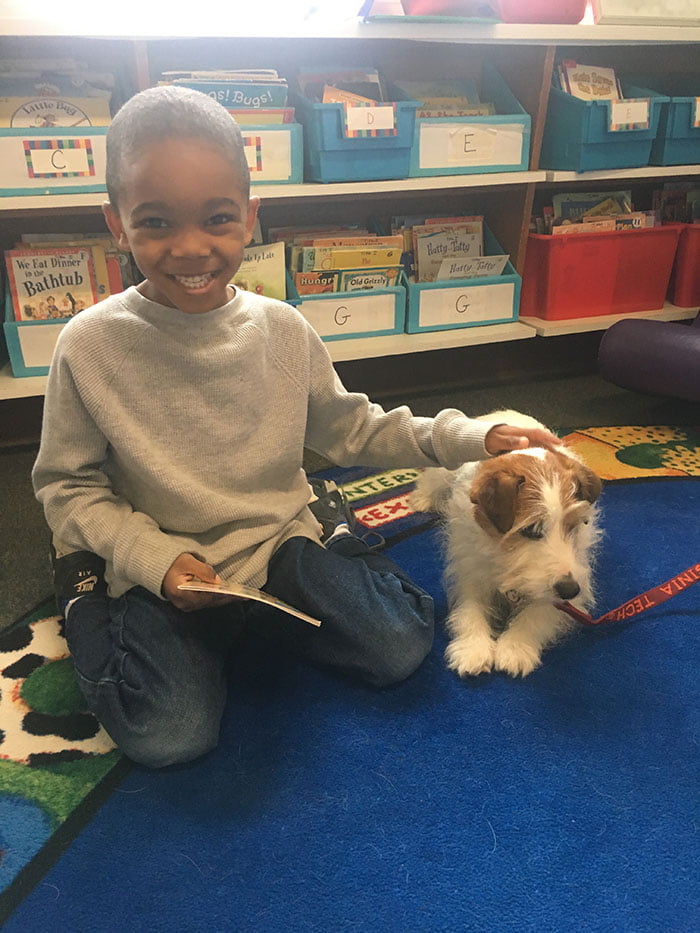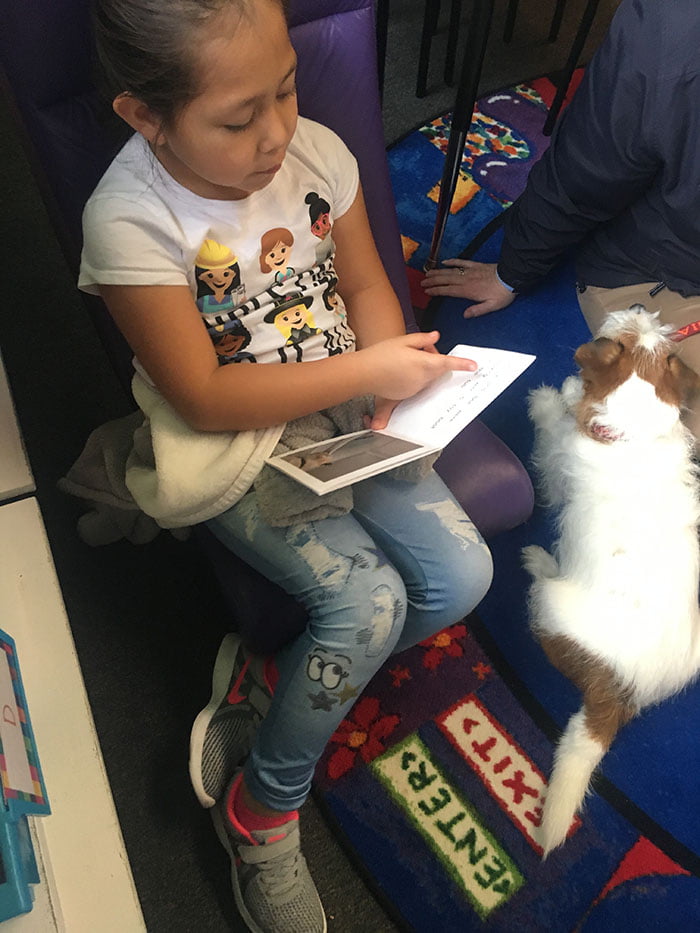RAFORD—Sitting cross-legged on a plump and colorful rug in a cozy classroom, Elyza Farrera is reading to Neville.
Farrera is a first-grader at McHarg Elementary School and Neville is a three-and-a-half-year-old Russell terrier. Farrera is pointing to the pictures and explaining them. Neville listens companionably with his chin on his paws.
McHarg first-graders Elyza Farrera Gonzalez (left photo) and Kayden Brown, both first graders at McHarg Elementary School are delighted to read with Neville, the Russell terrier who is a trained therapy animal. Reading to animals programs are happening in schools and libraries, giving children an opportunity for reading time with a companionable reading partner and good listener.
McHarg teacher Kelly Wheeler, who works with first graders like Farrera in reading at the elementary school, introduced a read-to-a-dog program in March, and Neville, a Russell terrier, comes to McHarg once a month to be petted and listen to students read.
“Sometimes it’s intimidating reading to teachers and parents, but Neville doesn’t mind if you make mistakes,” Wheeler said.
Literacy for children is the first falling domino that determines a person’s life. Research shows clearly that poor reading skills at an early age can make a child dislike school, leading to dropping out, impacting not just learning, but health, social participation, self-esteem, hygiene and even safety at work.
The pattern is the same in developing and developed countries. Fifteen percent of the world’s population cannot read costing the planet $1 trillion a year according to literacy research.
But individual attention benefits kids who struggle with reading. Many libraries and schools, like McHarg, are holding “read to an animal” events and programs.
Christiansburg Public Library invites kids to come read to cats and the Radford Public Library has offered opportunities to read to dogs, cats and birds.
While high-quality research on the test-score effect of reading to animals is scant, evidence suggests the falling domino results of reading to an animal increases a child’s opportunity to read, in a circumstance that increases a child’s comfort and confidence with reading, making it more likely she will feel that reading is merely a pleasant, companionable thing to do throughout her life.
So Neville comes to Ms. Wheeler’s first graders once a month and children take turns reading to him. They know he comes on Tuesday, so prepare to show him their favorite books.
“They know Neville is coming, so they practice and are ready to read to him,” she said. In first grade, I try to give kids a choice and they’re very drawn to books about animals.”
One of the class’s favorites is a series about a Labrador Retriever called Danny and his owner-author, Mia Coulter, who photographs him and tells stories about the dog’s life.
“Neville was a good listener,” Farrera said. “He liked the ‘Danny’ books because they are awesome! They have pictures of a real dog!”
Teacher Wheeler already knew about animal-human interaction research and the use of therapy animals to bolster literacy in children. So, when the entire school was reading a book called ‘Fenway and Hattie’, by Victoria Coe, in which the main character is an energetic Russell terrier, she decided to start a program.
“I thought it would be great for kids to read to a little dog. It’s just special to get to read to a dog and a lot of kids like dogs, but don’t have them at home,” she said.
She contacted Pet Partners, a non-profit that registers therapy dogs and other therapy animal pets including cats, birds and miniature horses. They connected her to their local chapter VT Helping Paws and Rachael Carpenter Byron, Neville’s owner.
Heartbroken at the loss of their first family dog, they were looking for a new, child-friendly dog. A friend introduced puppy-Neville to Rachael’s family and her children, who were 6 and 8.
“Neville walked in our house, and instead of being interested in the new surroundings or our cats, he was all over the girls, sitting in their laps, licking their faces, playing with them. He walked in our house and picked us as his family for sure!”
The little girls named him for a Harry Potter hero and he’s got a busy schedule.
“Neville regularly visits Kipps Elementary School and the Blacksburg Children’s Museum. While he could work with grownups, there are only so many hours in the day, and he greatly prefers kids!” she said.
Because Carpenter is a Clinical Instructor of Anesthesiology at the Virginia-Maryland College of Veterinary Medicine, Neville is a therapy animal trained through VT Helping PAWS (Pet Assisted Wellness Service) program that works with Virginia-Maryland College of Veterinary Medicine for Virginia Tech students, faculty, staff, and alumni.
Through the program, both dog and handlers receive training
A 45-minute evaluation tests the dog in a wide variety of situations according to Byron helping them be comfortable around people, medical devices, tolerating petting/hugging/handling, other dogs, crowds, yelling and basic obedience. Handlers learn how to recognize stress in their pets too.
“After Neville passed the evaluation, we were ready to go visit!” Byron said.
People interested in participating with Pet Partners should know that good candidate animals for animal-assisted therapy would be pets that like meeting new people and are not upset by being in new places.
“Dogs will generally need to have been through basic obedience courses and know basic commands and don’t jump on people,” she said.
For more information about Pet Partners visit petpartners.org and for more information about reading opportunities with animals, visit the Montgomery-Floyd Regional Library site whose branches hold reading to animals events periodically http://mfrl.org/.





